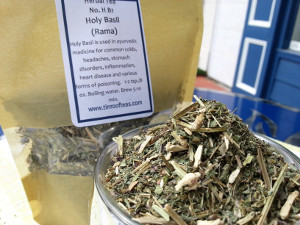What is Tulsi/Holy Basil?

Holy Basil has been revered for its medicinal value throughout India for thousands of years. Ayurvedic texts describe Holy Basil as a pillar of holistic herbal medicine and a plant that was incarnated from a goddess in plant form. Many traditional Hindus place the cherished plant within the courtyard of their home, and the plant continues to be cherished for its healing properties to this very day. The leaves give off a fragrance of peppermint, clove, licorice and lemon. Depending on the variety being used, of course.
So, what is Tulsi/Holy Basil good for? At this point in time, studies have found that the greatest potential of the plant seems to reside in areas of stress relief and relaxation. We all know that stress is an everyday part of life. It occurs when high demands are placed upon the bodies normal ability to cope with specific cortisol inducing situations. Holy basil acts as an adaptogen, enhancing the body’s natural response to physical and emotional stress. Lower levels of cortisol are associated with improved mental clarity and memory, as well as reducing the risk of age-related mental disorders.
Studies have also shown that Holy Basil can stimulate and vitalize your body. It protects against infections and helps to treat wounds, helps to lower your blood sugar, lowers cholesterol, eases inflammation and joint pain, as well as protecting the stomach.
There are three varieties of Tulsi used in today’s markets. Krishna, Rama, and Vana. All varieties belong to the mint family and are cousins of sweet basil.
Krishna
is known for its medicinal value and peppery crisp taste. The plant is dark green to purple leaves, stems, and blossoms. It is cultivated in the Indian plains, as well as private homes and gardens around India, and is named after the blue skinned God as the dark purple leaves resemble the dieties color.
Rama
is known for its cooling and mellow flavor. The plant has green leaves, white-to-purplish blossoms, and a green or purplish stem. It is cultivated in the Indian plains, as well as private homes and gardens in India.
Vana
“forest type”, is known for its fragrance. The plant has green leaves and stem, with white blossoms. It is found in the Himalayas and plains of India. Grows wild in Asia and Africa and is used medicinally there as well.
Source: www.medicinehunter.com/holy-basil
Source: www.chopra.com/articles/what-is-holy-basil#sm.00000o3qxwg4xhfd8pcsoy97h5748

